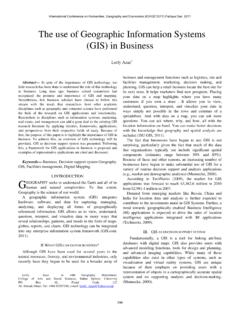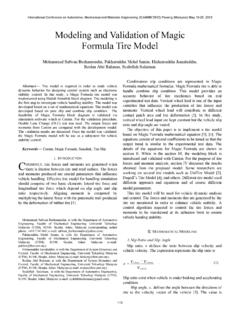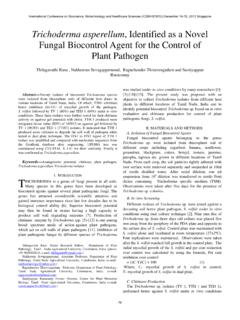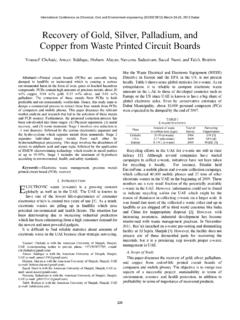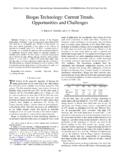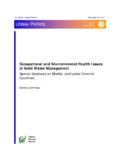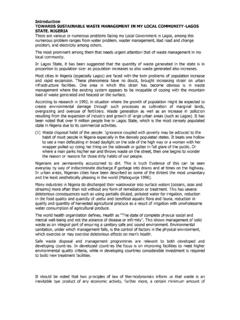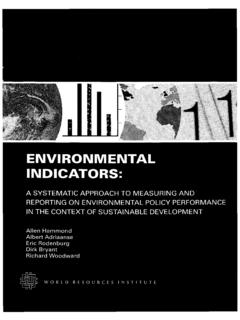Transcription of A Comparison of Waste Lubricating Oil Treatment Techniques
1 2nd International Conference on Environment, Agriculture and Food Sciences (ICEAFS'2013) August 25-26, 2013 Kuala Lumpur (Malaysia). A Comparison of Waste Lubricating Oil Treatment Techniques Motshumi J. Diphare, Edison Muzenda, Tsietsi J. Pilusa and Mansoor Mollagee innovative Treatment technologies have been developed that Abstract Waste Lubricating oil is a resource that cannot be promise to solve technical, economic and environmental disposed of randomly due to the presence of pollutants. In response problems associated with used oil recycling. to economic problems and environmental protection, there is a Reference [3] further motivates that 1 litre of Waste -oil re- growing trend to regenerate and reuse Waste lubricants [1]. The processed as fuel contains about 8000 kJ of energy, which is recovery Techniques discussed in this paper are reprocessing, re- refining and incineration of Waste Lubricating oil. The major objective enough to light a 100 W bulb for 24 hours. The efficient of this paper is to analyze and compare the regenerative technologies, recycling of Waste lubricant could help reduce both the thus creating the foundation for government, the private sector and environmental pollution and gas emission from greenhouses, other stakeholders in policy formation and selection of recovery thus creating an environmental and economic benefit [1].
2 Techniques . II. CHARACTERIZATION OF Waste LUBRICATION OIL. Keywords Regenerative Technologies, Re-refining, Reprocessing, Waste Oil, Waste Management The main constituents of Waste Lubricating oils are the base oil, degraded additives, metallic debris, oxidation products and I. INTRODUCTION carbon soot. A large number of additives are used to impart performance characteristics to the lubricants. The main M ANAGEMENT of Waste oils is a growing concern particularly in industrial and urban areas. Generation of Waste oils is closely linked with increase in population of additives are antioxidants, detergents, anti-wear elements, metal deactivators, corrosion inhibitors, rust inhibitors, friction modifiers, extreme pressure withstanding elements, anti- automobiles and industries. When additives and foreign foaming agents, viscosity index improvers, demulsifying or substances, such as metal powder, chips and other particles, emulsifying agents and stickiness improver. are mixed with Lubricating oil, aging, degrading and failure During their use, these additives lose their characteristics will likely occur, leading to mechanical fault and degraded rendering the lube oil non usable for Lubricating purpose.
3 In performance [1]. In such cases, the oil is replaced to improve addition, during their use, the Lubricating oils and the metal the performance. The used, spent or Waste oils should be processing oils pick up fractions of various metals as a result collected and recycled not only to prevent the environment of wearing out of components. The concentration of these pollution but also to preserve natural resources. impurities depends purely on the application to which the The management of Waste oils is particularly important particular oil is put to. Some contaminants, such as chlorinated because of the large quantities generated globally through solvents, water, unburned fuel, carbon and dust are also picked transport and Industrial activities. These Waste Oils may have up by the Waste oil during use or during storage. detrimental effect on the environment if not properly handled, treated or disposed [2]. In recent decades a number of Motshumi J Diphare is with the Department of Chemical Engineering, Faculty of Engineering and the Built Environment, University of Johannesburg, Doornfontein, Johannesburg 2028, South Africa, (email: Edison Muzenda is a part-time Energy and environmental Engineering Specialist the with Process, Energy and environmental Technology Station as well as Professor of Chemical Engineering, Department of Chemical of Chemical Engineering, Faculty of Engineering and the Built Environment, University of Johannesburg, Doornfontein, Johannesburg 2028, Tel: +27115596817, Fax: +27115596430, (email: Jefrey Pilusa is with the Department of Mechanical Engineering Science at the University of Johannesburg, Auckland Park, Johannesburg 2028, South Africa, (email: Mansoor Mollagee is with the Process, Energy and environmental Technology Station, University of Johannesburg, Doornfontein, Johannesburg Fig.)))
4 1 Percentage contribution of Waste oils [2]. 2028 (e-mail: 106. 2nd International Conference on Environment, Agriculture and Food Sciences (ICEAFS'2013) August 25-26, 2013 Kuala Lumpur (Malaysia). III. environmental POLLUTION filtration and removal of coarse solids that can pose The contaminants in Waste oil have adverse environmental environmental hazard or operational problems. Treatment and health impacts. Reference [2] states that the presence of options include mainly physical processes like settling, degraded additives, contaminants, and by-products of filtration, or a combination of these operations. Unfortunately, degradation render Waste oils more toxic and harmful to health these processes alone are not sufficient to remove all chemical and environment than virgin base oils. If put into storm water contaminants in the oil, and inclusion of further Treatment drains or sewers, they can affect waterways and coastal waters processes such as clay contacting and distillation would reduce [4].)
5 When dumped in soil or sent to landfill, they can migrate the competitive advantage of Waste oil processors [3]. into ground and surface waters though numerous land Treatment processes. In addition, uncontrolled used oils are a threat to plant and animal life, which can further result in economic losses, for example, recreation and fishing industries. For example, used oil from internal combustion engines generally accumulates a variety of contaminants, which increase the oil's toxicity [5]. IV. IMPORTANCE OF USED OIL RECYCLING. A large range of Waste oils can be recycled and recovered in a variety of ways, either directly or after some form of separation and refinement. As per the Waste management Fig. 3 Block diagram of reprocessing of used Lubricating oils [2]. hierarchy, the first option is to conserve the original properties B. Re-refining of the oil allowing for direct reuse. Other options could Over the years several re-refining technologies have been include recovering its heating value and/or using in other proposed for Waste oil recycling.
6 Re-fining is the use of lower level applications. Certain types of Waste oils, lubricants distilling or refining processes on used lubrication oil to in particular, can be reprocessed allowing for their direct produce high quality base stock for lubricants or other reuse. The use of Waste oils, after Treatment , can be either as a petroleum products. The use of this method has increased lube base stock comparable to refined virgin base oil or as tremendously in developed countries, some countries reaching clean burning fuel. up to 50% of the country's need for Lubricating oil [8]. There are various methods developed by different western countries in the treating of used Lubricating oil for reuse. It requires the conversion of Waste oil to a product with similar characteristics to those of virgin oil. The process typically involves, but is not limited to, pre- Treatment by heat or filtration, followed by either vacuum distillation with hydrogen finishing or clay, or solvent extraction with clay and chemical Treatment with hydro-heating.
7 Vacuum distillation followed by Fig. 2 Waste oil hierarchy [2] clay contacting offers a less polluting and more economic solution to the re-refining process, particularly for small-scale V. Treatment TECHNOLOGIES plants with a capacity range between 10000 and 30000 tons The review of Waste lubricants Treatment Techniques were [3]. The resulting residual by-product is well compacted and discussed by the author [6]. Used oils have been recycled for baled in thick plastic sheets prior to disposal in landfills. the past four decade. The idea of recycling used Lubricating oil Participation of a reputable recycling company can play an was presented in the year of 1930. Initially the used Lubricating important role in enhancing the trust factor [9]. oils were burnt to produce energy, and later these oils were re- C. Incineration blended to engine oils after Treatment . Due to the increasing necessity for environmental protection and more stringent This method is preferable when the Waste oil is highly environmental legislation, the disposal and recycling of Waste contaminated, particularly with polychlorinated byphenyls oils has become very important [7].
8 The recycling of Waste (PCB) and polychlorinated terphenyls (PCT). In the absence Lubricating oils can be accomplished through three basic of hazardous Waste incinerators, controlled high-temperature methods, which are reprocessing, re-refining and destruction. incineration at cement factories is recommended. Temperatures at the flame end of rotating cement kilns ranges A. Reprocessing between 2000 and 2400 C. This high temperature is adequate The objective of re-processing is to produce a finished fuel to destroy organics and neutralize acid compounds [11]. The oil that is low in basic sediment and water content, and that heavy metals content is reduced considerably as their will not clog burners, foul boiler tubes, or cause sediment concentrations remain very low compared to those found in the build-up in customer tanks. As such, the process requires natural material used in the cement production process. Note, 107. 2nd International Conference on Environment, Agriculture and Food Sciences (ICEAFS'2013) August 25-26, 2013 Kuala Lumpur (Malaysia).
9 However, that continuous monitoring of gas emissions at the TABLE II. environmental Comparison OF Treatment TECHNOLOGIES [1]. cement factories would be required to ensure compliance with Regenerative Re- Reprocessi Destruct air quality standards [3]. Technology refining ng ion Acidic sludge High Low - Residual sludge High Low - Harmful Chemicals Sulfur - - ic acid Pollution Low Low High Ash - - Much TABLE III. ECONOMIC Comparison OF Treatment TECHNOLOGIES [1]. Regenerative Re- Reprocessi Destructio Technology refining ng n Technology maturity Plant Plant Scale - scale Energy demand High Low - Recovery rate 63 74 - Quality of reclaimed oil Good Fair - Fig. 4 Block diagram of re-refining of used Lubricating oils [2] Equipment demand High Low Low Operating cost High Low - TABLE I. COMPARISION OF Waste OIL MANAGEMENT Techniques [11]. Techni Advantage Disadvantage que Re- Environmentally sound Requires a well-developed refining long term solution collection system. Re-refined lube oil Creates jobs requires well developed market.
10 Reduces the amount of Requires extensive capital imported lubricant oil investment. The re-refining option requires a reputable recycling company to ensure the marketability of the product. Proper disposal of end- Fig. 5 Comparison of Lubricating oil properties before and after Waste residues are costly Treatment [11, 16]. Reproc Good substitute for Requires a well-developed essing second grade fuels. collection system. Limits the negative effects of the practice of Requires extensive capital uncontrolled burning of investment. Waste . The quality control of Proper disposal of end- the re-processed Waste residues are costly fuel oil is monitored by the purchaser Inciner Economically feasible Air emissions, although ation at lower processing minimal, still need to be volumes addressed. Cement factories are willing to procure the Opposition by regulatory Waste oil and government institutions Fig. 6 Comparison of Lubricating oil properties before and after Less capital intensive Treatment [11, 16].
